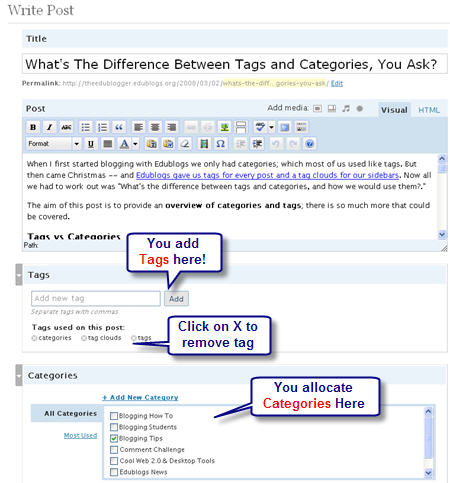When I first started blogging with Edublogs we only had categories; which most of us used like tags. But then came Christmas — and Edublogs gave us tags for every post and tag clouds for our sidebars. Now all we had to work out was “What’s the difference between tags and categories, and how would we use them?.”
The aim of this post is to provide an overview of categories and tags; there is so much more that could be covered.
Tags vs Categories
The whole reason why tags, categories, and search widgets are used on blogs is to serve one purpose — help your readers locate the information they want on your blog. Readers want quick and easy solutions; too hard and they look elsewhere.
While the aim of using tags and categories is the same — to help readers locate information — they are used differently.
Categories are like book chapters; they provide a general overview of the topics you blog about. Whereas tags are more like the index at the back of the book and explode the topic into a million bits.
Categories and tags are displayed in your blog sidebar using the categories widget and Tag cloud widget.
Categories Are Used For Categorizing
Let me show you. I’m currently using 17 categories on my Mobile Technology in TAFE blog. Unfortunately, I blog on a wide subject area, so I’ve so many categories. Ideally, I believe it would be better for me to use fewer categories and for the category’s names to be descriptive enough without using two lines.
Categories can have unique names and be wordy; you want them sufficiently descriptive so your reader understands the type of subject matter they will find when they click on the link. For example, my Cool Web 2.0 & Desktop Tools category contains all posts that review, road test, or tell my readers how to use Web 2.0 or desktop tools more effectively.
Posts can be allocated to more than one category; I assign Twitter posts using the categories Cool Web 2.0 & Desktop Tools and Microblogging Tips similarly those on Flickr are distributed using the categories Cool Web 2.0 & Desktop Tools and Photosharing and Editing Tips. Remember I’m doing this to make it easier for my readers to locate the information they need quickly.
Tags and Tag Clouds
Tags are displayed on your blog as a tag cloud; clicking on a tag name will take your readers to all posts tagged with that term. Tags are normally short, one or two words, and are generally keywords (i.e. terms readers would be likely to use if they searched your site); terms that your readers will understand.
The number of categories you allocate to a post is normally limited whereas you will use as many tags on a post as you like.
Tags or Categories: Which One To Use?
If you checked out problogger sites — you will see each has their own preference as to which they use, or if they use both.
However, if you are planning on using categories like I have, you really need to sit down, think carefully about what content you will blog, and allocate categories that reflect this. You may want to use the categories I use on my Mobile Technology in TAFE blog as a guide.
If you’re going to use categories you need to do it properly; your readers expect that when they click on a category they will get ALL posts on the topic. If you add new categories this means you will need to go back through old posts and allocate them to these new categories.
Creating categories can be time-consuming — if you want to promise a “good enough” system, then use tags, where no thoroughness is implied. You will still need to be consistent with tagging e.g. use widget, Widget or widgets not all three. It’s worth checking out popular tags for ideas of what to use — check out Edublogs tag cloud.
Changing my Mobile Technology in the TAFE blog from the old system of just categories to now using categories and tags did take time — I had to sort through 223 posts. If you’ve got lots of old posts it may be better to stick with how you’ve been doing it and add a search widget to the top of your blog.
FINAL THOUGHT
I’m definitely not an expert with categories and tags; thanks to all the people who helped me out in coming to terms with using them.
Recommend you also check out the difference between pages and posts plus how you can use categories to separate different subjects or classes on a blog.
If you are enjoying reading this blog, please consider ![]() Subscribing For Free!
Subscribing For Free!

great description, the more I learn the easier it is. I am not sure if I will ever catergorize so many things but the possibilties are endless. thanks again. Rev D…..